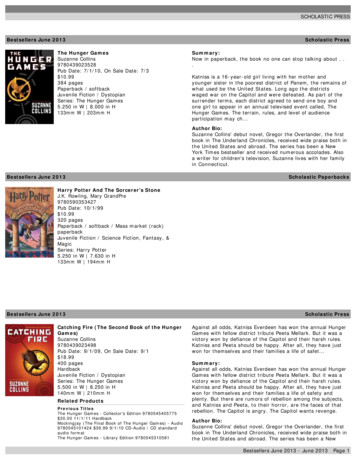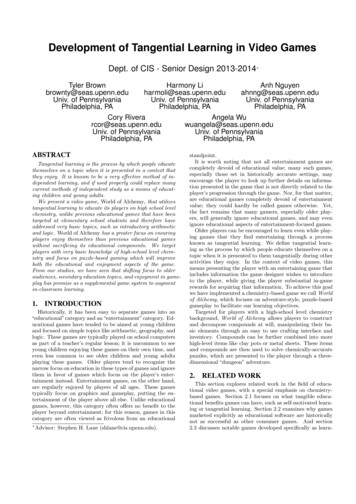
Transcription
Computer science activities with a sense of funWinning games:the perfect tictac-toe playerCreated by Peter McOwan and Paul Curzon ofQueen Mary, University of London with supportfrom EPSRC and Googlewww.cs4fn.org
Winning games: theperfect tic-tac-toe playerCreated by Paul Curzon, Queen Mary, University of London with support fromGoogle and EPSRCAge group: 10 – 11 Abilities assumed: general problem solvingTime: 50 minutes upwardsSize of group: 4-30FocusWhat is a program?How can computers beat humans at games?SummaryThe group works in teams to create sets of instructions (a “program”) to play the game of noughts and crosses/ tic-tac-toe. This is followed by a tournament between the different teams’ programs to see which plays best.AimsThis activity introduces programming and explores how a computer is able to win at board games like chess.The emphasis is on programming being about solving the problem rather than about being able to write in aprogramming language.Technical termsProgram, artificial intelligence, game tree.Materials Move card sets: 9 for each team Instruction board for player 1: 1 for each team Instruction board for player 2: 1 for each team Set of random move cards: 1 for each team Paper, pencils Chess computer (optional – just to wave around!) Giant noughts and crosses board (optional) – alternatively can be done on a white boardComputer science activities with a sense of funwww.cs4fn.org
What to doPreparation:Copy enough sets of materials for the class and cut up the “move cards” into piles.Each group will need nine sets of ten cards.The grab:One grab is to start with the “intelligent piece of paper” activity. It both acts as a grab and gives an idea of whatthe aim of the main task is. Show the class a chess computer. Explain that humans are no longer the bestgame players on the planet. Machines are!Explain the following:In the 1950s it was suggested that one day a computer would beat the best humans at chess. Chess playersridiculed the idea. They said it took real intelligence to play chess, something a machine could never have. In1997 Deep Blue, a chess computer, beat Garry Kasparov, the world chess champion, in a tournament rulesmatch. Was Deep Blue the more intelligent? It was just following a program: following instructions written bycomputer programmers. How did it do it? In this activity we will explore how computers can win at games bycreating a program to play noughts and crosses (tic-tac-toe).The set-up:Split the class into groups of 4-6 students. Each group is challenged to come up with a program (a set ofinstructions) that plays the game of noughts and crosses perfectly. A person who knows nothing about thegame should never lose if they follow the group’s instructions. If both players play perfectly then the gameshould end in a draw, so the minimum aim is that the program should never lose. It should be able to win,however, if the opponent makes a mistake.How? Each team creates a sequence of instructions to be followed for each of the nine moves of a full game.This means programming five sequences of instructions for player 1 and four sequences of instructions forplayer 2.The instructions that can be used are restricted to those on the instruction cards provided. The instructionsthat are available for each move are as follows: Go for 3 in a line Block 3 in a line Go in the opposite corner to my last corner move Go in the opposite corner to the other player’s last corner move Go in a free space Go in a free corner Go in the centre Go in an edge square (not a corner) If the other player holds opposite corners then go in an edge (not corner) Go in a corner on the same side as my last corner moveThe instructions must be put into a pile giving the order in which to try them for each move. Once they havedecided the order, the teams write a number on each card to indicate its position in the pile for that move.Then they are put into a pile on the move board. Ultimately each teacher should have a pile of one or morecards on each position of their move boards.Computer science activities with a sense of funwww.cs4fn.org
ExampleThe simplest program that plays successfully (if poorly) would be to have a single instruction for every move:1. Go in a free space(As this program does not say which space to go in, the space is chosen randomly from those available.See how below.)Each move’s program can be made of more than one instruction. For each move, the program runs down thelist of instructions until it finds an instruction that it can execute. For example a possible list for a move is:1. Go in the centre2. Go in a free corner3. Go in a free spaceThat means that the first instruction to be tried for this move is to go in the centre of the board. However, ifthat is impossible (e.g. because the other player has already gone there) try the second instruction in the listinstead: attempt to go in a free corner.As this instruction does not say which corner to go in and several may be free, the specific one would again bechosen randomly (see below). If all the corners are used up too, the third instruction is followed instead andyou go in a free space.A list of instructions of this form is needed for each move. For example, a simple (and attacking) program forplaying first would be:PLAYER 1, MOVE 1:1 Go in the centre2 Go in a free spacePLAYER 1, MOVE 2:1 Go in a free corner2 Go in a free spacePLAYER 1, MOVE 3:1 Go for 3 in a line2 Go in a free spacePLAYER 1, MOVE 4:1 Go for 3 in a line2 Go in a free spacePLAYER 1, MOVE 5:1 Go in a free spaceThe teams should be able to create a better player than this though. It can be beaten! They also need to comeup with the moves for player 2.The instructions “Go for 3 in a line” and “Block 3 in a line” are obviously very important. They refer to thesituations where either you or your opponent already has two pieces in a line with the other square free soa win is possible. Of course, they may not help if your opponent manages to guarantee a win first!What if none of the moves apply?If you get to the end of the list of instructions to try for a move, with none of the instructions being possiblethen the player resigns. HINT: It is always a good idea to include “Go in a free space” as the last instructionof every list. It ensures you can always make some legal move.If you prefer the rules to be less harsh then you can make playing randomly the default move if nothing else ispossible.Computer science activities with a sense of funwww.cs4fn.org
Random movesIf an instruction does apply but there are several possible squares it could refer to (such as “Go in a freecorner” when all the corners are free), then one of them is chosen randomly. An easy way to do this is to takethe number cards provided that correspond to the squares concerned. Shuffle them, place them face downand allow the player to take one at random. The number on the chosen card is the place to move.Use the numbered board provided as a key to where the number chosen requires you to go.Creating programsGive the teams the instruction cards and paper and pencils. Their first task is to work out a strategy to play.What is the best first move to play for example? How can you stop the other player winning next move? Getthem to play a rapid series of games in pairs to get an idea of how best to play, noting what seems the bestthing to do.Next they should try and turn their ideas into instructions, picking those cards they think are useful for eachmove and making a pile for that move in its slot on the instruction boards. Suggest at this point they split intwo, with some in charge of creating the instructions for player 1 and the others in charge of player 2.Once they have a program they think works they should use the position box on the cards to indicate the orderin which the instructions should be tried for that move.Testing their programThey should next try the program they have created to see how good it is. One person in the team should playagainst it. The instructions should be followed exactly.For each move of the program, first take the top card from the pile for that move. If that move is possible,make it. Otherwise discard it and try the next card’s instruction.Emphasise that if the instructions give a free choice, the move MUST be made randomly, using the randomnumber cards.At the end of the move, put the cards back in their original order. The students may wish to then tweak theinstructions to improve them.TournamentAs the last part of the session hold a tournament between the different teams’ programs. This is most fun ifmatches are done one at a time around a large board, either on the floor or on a whiteboard. Rather than theteam following their own program, a neutral person should take them and “execute” them impartially, doingexactly what the piles of instructions say. A referee (you) should ensure fair play.The format used will depend on the numbers involved. The easiest is to use a round robin format where ineach round different pairs of programs play against each other.Each match should consist of each program playing for both player 1 and player 2.Give 2 points for a win, 1 for a draw and -2 for a loss. Remember the aim is, first of all, not to lose!Repeat this over a series of rounds with different teams playing each other. The champion is the one amassingthe most points (or if there is time you could finish with a knock-out stage).Round upSummarise what the class has done. They have each created a program (lists of instructions) for playingnoughts and crosses. Anyone (or anything) that can follow the instructions can do so and play well (if theinstructions are good). That is all a computer does: follow the instructions in its programs. In fact everycomputerised gadget from a mobile phone to a washing machine is doing just that. They follow the instructionsthat programmers write. As we have seen, programming is very creative.You have to come up with instructions that solve the problem whatever happens. Creating good instructions forchess is what the programmers of Deep Blue, the best chess player on the planet, did so successfully!Computer science activities with a sense of funwww.cs4fn.org
Is all the intelligence just in the programmers though? Bear in mind that Deep Blue can play chess better thanthe people who programmed it. They would not have beaten Kasparov. Deep Blue on the other hand could,because it could follow instructions incredibly quickly and, just as importantly, accurately. In fact a chesscomputer’s instructions don’t tell it what moves to play directly, they tell it how to search for the best movesby playing ahead in the game and checking the results.but that is a future activity.Variations and extensionsFor a longer session, after the first tournament you could introduce the idea of game trees – exhaustivelyexploring all the possible moves. The teams should try playing the game in a methodological way and attemptto create a game tree for playing perfectly. For example, first explore the possible games if the first player goesin the centre. Then explore the games if the first move is in the corner. Once done they should create a newset of instructions to play that way.If you wish to show a good set of rules at the end to compare the class’s with, the following play well.Make the tournament the right to play against these “current world champion” rules.Player 1MOVE 1:1 Go in a free corner2 Go in the middleMOVE 2:1 Go in the opposite corner to my last corner move2 Go in a free cornerMOVE 3:1 Go for 3 in a line2 Block 3 in a line3 Go in a free corner4 Go in a free spaceMOVE 4:1 Go for 3 in a line2 Block 3 in a line3 Go in a free corner4 Go in a free spaceMOVE 5:1 Go in a free spacePlayer 2MOVE 1:1 Go in the centre2 Go in a free cornerMOVE 2:1 Block 3 in a line2 If the other player holds opposite corners then go in an edge (not corner)3 Go in the opposite corner to the other player’s last corner move4 Go in a free cornerMOVE 3:1 Go for 3 in a line2 Block 3 in a line3 Go in a free corner4 Go in a free spaceMOVE 4:1 Go for 3 in a line2 Block 3 in a line3 Go in a free corner4 Go in a free spaceIt is possible to play even better than these rules (though not by much) – think about maximising theopportunities for the other player to make a mistake.Computer science activities with a sense of funwww.cs4fn.org
Further readingHow do computers get to be so smart?Read about the rules that will make you a perfect noughts and crosses Write your own perfect playerWrite you own program and pit it against our perfect player nning at Nim: computers outwitting humansOne of the earliest games the computers outwitted us at was Nim. Follow the links and you can play our onlineHamster Nim too.www.cs4fn.org/binary/nim/nim.phpGo, go gadget: computers' biggest gaming challengeComputers are the best game players on the planet.or are they? Humans can still beat them at the gameof go.www.cs4fn.org/ai/gogogadget.phpLinks to other activitiesThe intelligent piece of paperTake part in a test of intelligence against an intelligent piece of paper! This is a good introduction to what acomputer program is, and also to start a discussion on what it would mean for a computer to be intelligent.www.cs4fn.org/teachers/activities/The sweet learning computerMake a computer that teaches itself to play a game perfectly. A computer can be programmed to work therules of how to play the game out for itself (so where is the intelligence then?) This activity is one way toillustrate how that can be done.www.cs4fn.org/teachers/activities/Computer science activities with a sense of funwww.cs4fn.org
Number cardsfor random moves123456789Ensure these are printed onto card thick enough that the number is notvisible from the back. Use the following numbered board as the key.Computer science activities with a sense of funwww.cs4fn.org
Board positions forrandomly chosen numbers123456789Computer science activities with a sense of funwww.cs4fn.org
Move Cards:Player 1, Move 1Player 1, Move 1Player 1, Move 1Go for 3 in a lineBlock 3 in a linePositionPositionPlayer 1, Move 1Go in the opposite corner to mylast corner movePositionPositionPlayer 1, Move 1Player 1, Move 1Go in a free spaceGo in a free cornerPositionPositionPlayer 1, Move 1Go in the centrePositionPlayer 1, Move 1If the other player holdsopposite corners then go in anedge (not a corner)PositionPlayer 1, Move 1Go in the opposite corner tothe other player’s lastcorner movePlayer 1, Move 1Go in an edge square(not a corner)PositionPlayer 1, Move 1Go in a corner on the sameside as my last corner movePositionComputer science activities with a sense of funwww.cs4fn.org
Move Cards:Player 1, Move 2Player 1, Move 2Player 1, Move 2Go for 3 in a lineBlock 3 in a linePositionPositionPlayer 1, Move 2Go in the opposite corner to mylast corner movePositionPlayer 1, Move 2Go in the opposite corner tothe other player’s lastcorner movePositionPlayer 1, Move 2Player 1, Move 2Go in a free spaceGo in a free cornerPositionPositionPlayer 1, Move 2Player 1, Move 2Go in an edge square(not a corner)Go in the centrePositionPlayer 1, Move 2If the other player holdsopposite corners then go in anedge (not a corner)PositionPositionPlayer 1, Move 2Go in a corner on the sameside as my last corner movePositionComputer science activities with a sense of funwww.cs4fn.org
Move Cards:Player 1, Move 3Player 1, Move 3Player 1, Move 3Go for 3 in a lineBlock 3 in a linePositionPositionPlayer 1, Move 3Go in the opposite corner to mylast corner movePositionPlayer 1, Move 3Go in the opposite corner tothe other player’s lastcorner movePositionPlayer 1, Move 3Player 1, Move 3Go in a free spaceGo in a free cornerPositionPositionPlayer 1, Move 3Player 1, Move 3Go in an edge square(not a corner)Go in the centrePositionPlayer 1, Move 3If the other player holdsopposite corners then go in anedge (not a corner)PositionPositionPlayer 1, Move 3Go in a corner on the sameside as my last corner movePositionComputer science activities with a sense of funwww.cs4fn.org
Move Cards:Player 1, Move 4Player 1, Move 4Player 1, Move 4Go for 3 in a lineBlock 3 in a linePositionPositionPlayer 1, Move 4Go in the opposite corner to mylast corner movePositionPlayer 1, Move 4Go in the opposite corner tothe other player’s lastcorner movePositionPlayer 1, Move 4Player 1, Move 4Go in a free spaceGo in a free cornerPositionPositionPlayer 1, Move 4Player 1, Move 4Go in an edge square(not a corner)Go in the centrePositionPlayer 1, Move 4If the other player holdsopposite corners then go in anedge (not a corner)PositionPositionPlayer 1, Move 4Go in a corner on the sameside as my last corner movePositionComputer science activities with a sense of funwww.cs4fn.org
Move Cards:Player 1, Move 5Player 1, Move 5Player 1, Move 5Go for 3 in a lineBlock 3 in a linePositionPositionPlayer 1, Move 5Go in the opposite corner to mylast corner movePositionPlayer 1, Move 5Go in the opposite corner tothe other player’s lastcorner movePositionPlayer 1, Move 5Player 1, Move 5Go in a free spaceGo in a free cornerPositionPositionPlayer 1, Move 5Player 1, Move 5Go in an edge square(not a corner)Go in the centrePositionPlayer 1, Move 5If the other player holdsopposite corners then go in anedge (not a corner)PositionPositionPlayer 1, Move 5Go in a corner on the sameside as my last corner movePositionComputer science activities with a sense of funwww.cs4fn.org
Move Cards:Player 2, Move 1Player 2, Move 1Player 2, Move 1Go for 3 in a lineBlock 3 in a linePositionPositionPlayer 2, Move 1Go in the opposite corner to mylast corner movePositionPlayer 2, Move 1Go in the opposite corner tothe other player’s lastcorner movePositionPlayer 2, Move 1Player 2, Move 1Go in a free spaceGo in a free cornerPositionPositionPlayer 2, Move 1Player 2, Move 1Go in an edge square(not a corner)Go in the centrePositionPlayer 2, Move 1If the other player holdsopposite corners then go in anedge (not a corner)PositionPositionPlayer 2, Move 1Go in a corner on the sameside as my last corner movePositionComputer science activities with a sense of funwww.cs4fn.org
Move Cards:Player 2, Move 2Player 2, Move 2Player 2, Move 2Go for 3 in a lineBlock 3 in a linePositionPositionPlayer 2, Move 2Go in the opposite corner to mylast corner movePositionPlayer 2, Move 2Go in the opposite corner tothe other player’s lastcorner movePositionPlayer 2, Move 2Player 2, Move 2Go in a free spaceGo in a free cornerPositionPositionPlayer 2, Move 2Player 2, Move 2Go in an edge square(not a corner)Go in the centrePositionPlayer 2, Move 2If the other player holdsopposite corners then go in anedge (not a corner)PositionPositionPlayer 2, Move 2Go in a corner on the sameside as my last corner movePositionComputer science activities with a sense of funwww.cs4fn.org
Move Cards:Player 2, Move 3Player 2, Move 3Player 2, Move 3Go for 3 in a lineBlock 3 in a linePositionPositionPlayer 2, Move 3Go in the opposite corner to mylast corner movePositionPlayer 2, Move 3Go in the opposite corner tothe other player’s lastcorner movePositionPlayer 2, Move 3Player 2, Move 3Go in a free spaceGo in a free cornerPositionPositionPlayer 2, Move 3Player 2, Move 3Go in an edge square(not a corner)Go in the centrePositionPlayer 2, Move 3If the other player holdsopposite corners then go in anedge (not a corner)PositionPositionPlayer 2, Move 3Go in a corner on the sameside as my last corner movePositionComputer science activities with a sense of funwww.cs4fn.org
Move Cards:Player 2, Move 4Player 2, Move 4Player 2, Move 4Go for 3 in a lineBlock 3 in a linePositionPositionPlayer 2, Move 4Go in the opposite corner to mylast corner movePositionPlayer 2, Move 4Go in the opposite corner tothe other player’s lastcorner movePositionPlayer 2, Move 4Player 2, Move 4Go in a free spaceGo in a free cornerPositionPositionPlayer 2, Move 4Player 2, Move 4Go in an edge square(not a corner)Go in the centrePositionPlayer 2, Move 4If the other player holdsopposite corners then go in anedge (not a corner)PositionPositionPlayer 2, Move 4Go in a corner on the sameside as my last corner movePositionComputer science activities with a sense of funwww.cs4fn.org
Instruction Board,Player 1PLAYER 1, MOVE 1PLAYER 1, MOVE 2PLAYER 1, MOVE 3PLAYER 1, MOVE 4PLAYER 1, MOVE 5Computer science activities with a sense of funwww.cs4fn.org
Instruction Board,Player 2PLAYER 2, MOVE 1PLAYER 2, MOVE 2PLAYER 2, MOVE 3PLAYER 2, MOVE 4Computer science activities with a sense of funwww.cs4fn.org
In the 1950s it was suggested that one day a computer would beat the best humans at chess. Chess players ridiculed the idea. They said it took real intelligence to play chess, something a machine could never have. In 1997 Deep Blue, a chess computer, beat Garry Kasparov, the world










